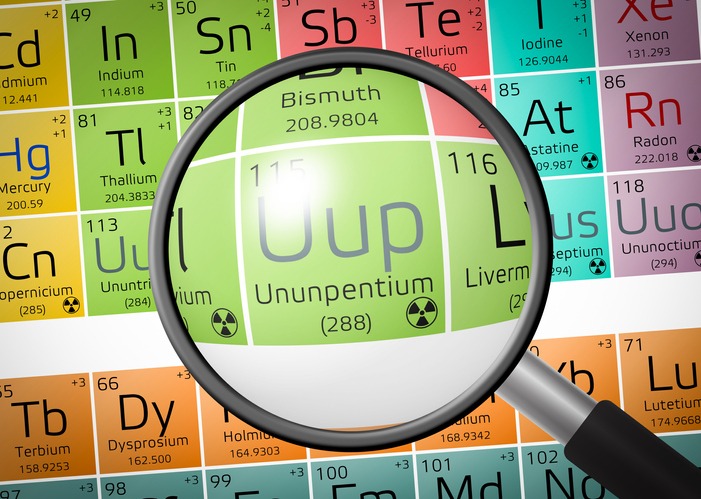As late as the early 21st century in chemistry, a new element was discovered – the ununpentium.
Ununpentium is the temporary name of element 115; which is an extremely heavy synthetic element, categorized probably as a poor metal. In the periodic table, it has the still-working (as of yet) symbol Uup. Its atomic number 115 is where the element’s name is derived from (“ununpentium” is translated roughly as “one-one-five”).
It was revealed in February 2004 that a new element was formed as a result of the experiments carried out between July and August 2003 by a joint collaboration of Russian scientists (at Joint Institute for Nuclear Reserach in Dubna) and American scientists (in Lawrence Livermore National Laboratory in California).
Through using a special machine called a cyclotron, those scientists used americium-243 – which is a kind of unstable, radioactive element – with ions of calcium-48, (whose atoms are much lighter than the americium atoms), producing four atoms: the ununpentium-287 (one atom) and ununpentium-288 (three atoms). These atoms are short-lived and easily decay into ununtrium by alpha particle emission.
When Russian chemist Dmitri Mendeleev published the modern periodic chart in 1869, there were only just over fifty entries on it, and he left many blanks in his table that indicated that there were elements that would be discovered in the future, including the hypothetical or predicted elements (e.g., elements that aren’t yet officially recognized as true elements until they’re discovered).
These hypothetical elements were given names such as ekaaluminum or ekasilicon – elements that exhibit some similar components to these substance that are already known. Eka is a Sanskrit prefix meaning one, so literally ekaaluminum and ekasilicon mean one aluminum and one silicon respectively, and so on and so forth. For instance, francium was once referred to as ekacesium until its discovery during the early 20th century.
Ununpentium, in this case, is called aeka-bismuth which is a homologue to bismuth, only much heavier. It is a temporary element recognized by the International Union of Pure and Applied Chemistry (IUPAC) which also has the final decision on assigning the element 115 with the name ununpentium.
Because ununpentium has produced only a few atoms, it currently has no practical uses beyond being the object of scientific research, owing to its instability.
This initial research in 2003 and subsequent studies after that, haven’t yet provided enough evidence to validate the existence of this element.
Then comes a most recent development on element 115 aka ununpentium. Just this August 2013 (as of this writing), a group of Swedish physicists at Lund University announced that they have backed up the 2004 study by bombarding a thin film of americium with calcium ions. The following month, a team of international researchers at GSI Helmholtz in Darmstadt, Germany reported that there is sufficient evidence to support the existence of element 115 aka ununpentium.
This recent development will only take a review conducted by IUPAC to officially confirm the existence of a new element. Only then – if positively proven – the element 115 will be given a new official name and will be formally included in the periodic table.
Perhaps after IUPAC has found the evidence feasible enough and officially made the element 115 a true element, then all of us lay people will finally get to know what it really does and how do we benefit from it.
Useful related links
- Ununpentium
Ununpentium’s properties, discovery, videos, images, states, energies, appearance and characteristics. - WebElements Periodic Table of the Elements | Ununpentium | Essential information
This WebElements periodic table page contains Essential information for the element ununpentium - Ununpentium – Wikipedia, the free encyclopedia

